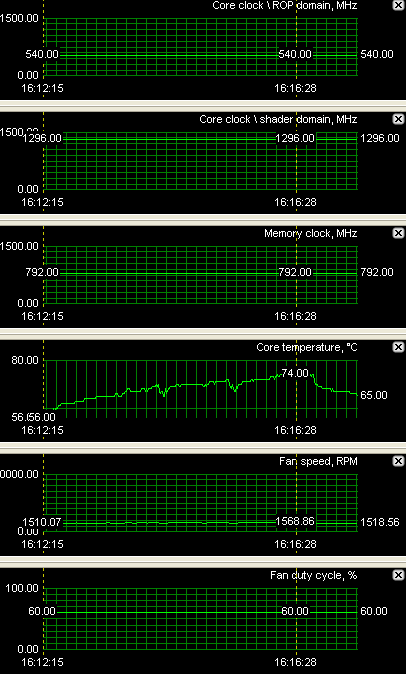Page 4
Le 4ème pouvoir "The Fourth Power"
We'll now show you some tests we have done on overall power consumption of the PC. Looking at it from a performance versus wattage point of view the power consumption is not as bad as I expected it to be.
Our test system is a Core 2 Duo X6800 Extreme Processor, the nForce 680i mainboard, a passive water-cooling solution on the CPU, DVD-ROM and WD Raptor drive.
|
|
|||||||||||
|
|||||||||||
The methodology is simple: we look at the peak wattage during a 3DMark05 session to verify power consumption. You are not looking at the power consumption of the graphics card, but the consumption of the entire PC.
We had a total system wattage peak at roughly 310 Watts for the 8800 GTS edition cards, which is a lot but not excessive. This number will likely be 300 Watts for non-overclocked models. As you know we are also testing SLI today and with the same system setup in SLI we had a power draw of 392 Watt.
So here's my power supply recommendation:
- A single GeForce 8800 GTS requires you to have a 450 Watt power supply unit at minimum if you use it in a high-end system. That power supply needs to have (in total) at least 26 Amps available on the 12 volts rails.
- A second GeForce 8800 GTS installed on this system requires you to have a 600 Watt power supply unit at minimum if you use it in a high-end system. That power supply needs to have (in total) at least 36 Amps available on the 12 volts rails.
There are many good PSU's out there, please do have a look at our many PSU reviews as we have loads of recommended PSU's for you to check out in there. What would happen if your PSU can't cope with the load?:
- bad 3D performance
- crashing games
- spontaneous reset or imminent shutdown of the PC
- freezes during gameplay
- PSU overload can cause it to break down
Dangerous Liaisons - temperatures of the graphics card
Let's have a look at the temperatures these reference design coolers produce. We measured at a room temperature of 22 Degrees C.
|
|
||
 |
||
Despite the faster core frequency on the XFX model temperatures were pretty much the same (they do use the same cooler), so I inserted only one graph of our temp-monitoring process in here. This is the result of the BFG card by the way. You'll notice that when the card is idling (desktop mode) it's roughly at 55 Degrees C.
The peak temperature when the product is utilized at 100% roughly 75 degrees C. Now if you find this to be high then grab the latest Rivatuner and force the cooling unit to 60% or higher RPM utilization. It's not a lot more noisy yet temps will drop quickly.
Noise Levels coming from the graphics card
When graphics cards produce a lot of heat, usually that heat needs to be transported away from the hot core as fast as possible. Often you'll see massive active fan solutions that can indeed get rid of the heat, yet all the fans these days make the PC a noisy son of a gun. I'm doing a little try out today with noise monitoring, so basically the test we do is extremely subjective. We bought a certified dBA meter and will start measuring how many dBA originate from the PC. Why is this subjective you ask? Well, there is always noise in the background, from the streets, from the HD, PSU fan etc etc, so this is by a mile or two not a precise measurement. You could only achieve objective measurement in a sound test chamber.
The human hearing system has different sensitivities at different frequencies. This means that the perception of noise is not at all equal at every frequency. Noise with significant measured levels (in dB) at high or low frequencies will not be as annoying as it would be when its energy is concentrated in the middle frequencies. In other words, the measured noise levels in dB will not reflect the actual human perception of the loudness of the noise. That's why we measure the dBa level. A specific circuit is added to the sound level meter to correct its reading in regard to this concept. This reading is the noise level in dBA. The letter A is added to indicate the correction that was made in the measurement. Frequencies below 1kHz and above 6kHz are attenuated, where as frequencies between 1kHz and 6kHz are amplified by the A weighting.
|
|
|||||||||||||||||||||||||||||||||||||||
|
|||||||||||||||||||||||||||||||||||||||
We startup a benchmark and leave it running for a while. The fan starts to rotate faster and makes a moderate noise. We take the dBA meter, move away 75 CM and then aim the device at the active fan on the graphics card. We measure roughly 44-45 dBa which is to be considered a quiet noise level coming from the PC yet also a norm as most of our tests end up at this sound level. Again, this is a very subjective test and that dBa level includes all noise in the environment.
